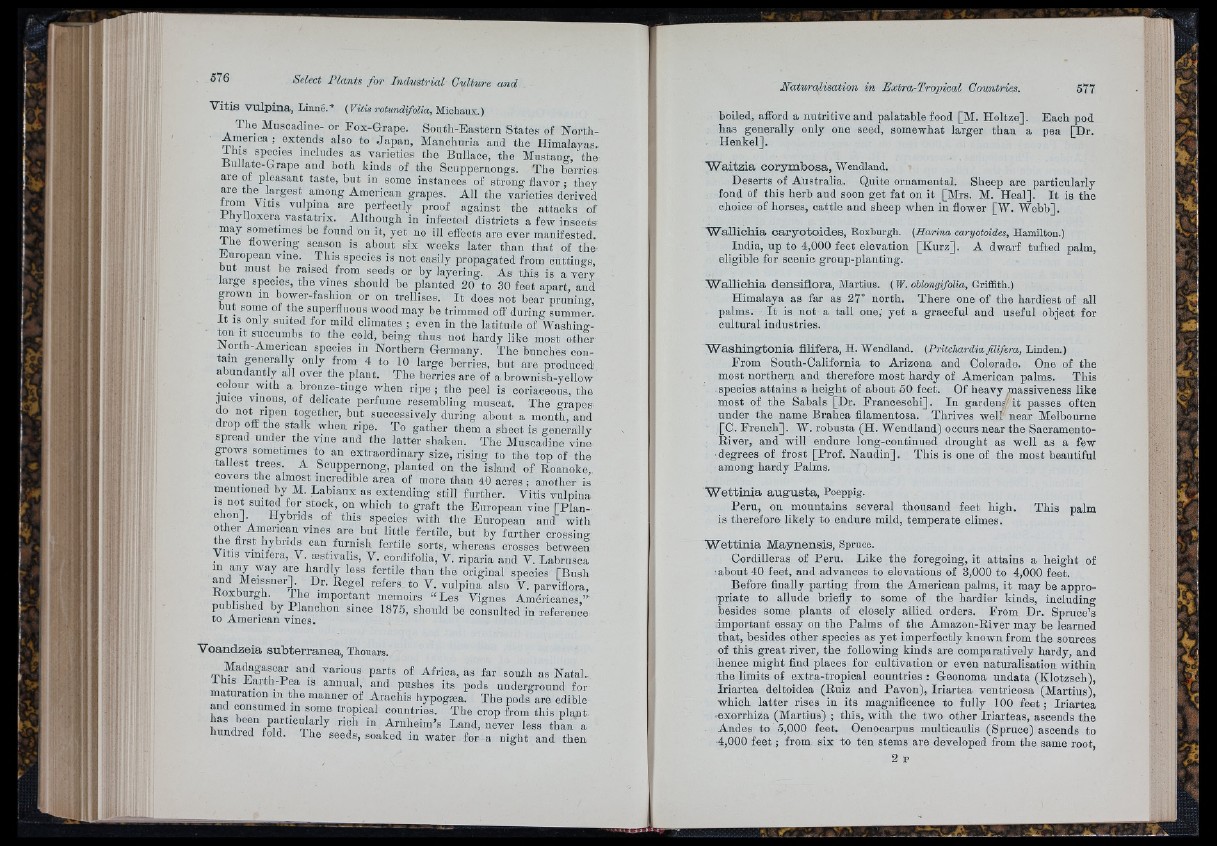
Il
Vitis vulpina, Linné.* ( Vilis rotundifolia, Michaux.)
The Miiscadiiie- or Fox-Grape. South-Eastern States of North-
Amerioa ; extends also to Japan, Manchuria and the Himalayas,
foils species includes as varieties the Bnilaoe, the Mustang, the
Bullate-Grape and both kinds of the Scuppernongs. The berries
are ot pleasant taste, but in some instances of strong flavor ; they
are the largest among American grapes. All the varieties derived
»0111 Vitis vulpma are perfectly proof against tlie attacks of
Phylloxéra vastatrix. Although in infected" districts a few insects
may sometimes be found on it, yet no ill effects are ever manifested,
iiie flowering season is about six weeks later than th a t of the
European vine. This species is not easily propagated from cuttings,
but must be raised from seeds or by layering. As this is a very
large species, the vines should be planted 20 to 30 feet apart, and
grown in bower-fashion or ou trellises. I t does not bear priinino-
bnt some of the superfluous wood may be trimmed off during summer
I t IS only suited for mild climates ; even in the latitude of Washiiiu-
ton It succumbs to the cold, being thus not hardy like most otlmr
North-American species in Northern Germany. The bunches contain
generally only from 4 to 10 large berries, but are produced
abnndantly all over the plant. The berries are of a brownish-yellow
colour with a brouze-tinge when ripe ; tbe peel is coriaceous, the
juice vinous, of delicate perfume resembling muscat. The grapes
do not ripen togetlier, but successively during about a month, and
drop off the stalk when ripe. To gather them a sheet is generally
spread under the vine and the latter shaken. The Muscadine vine
grows sometimes to an extraordinary size, rising to the top of the
tallest trees. A Souppernong, planted on the island of Roanoke,
covers the almost incredible area of more than 40 acres ; another is
mentioned by M. Labiaux as extending still further. Vitis vulpina
IS not suited for stock, ou which to graft the European vine [Plan-
chonj. Hybrids of this species with the European and with
ofoer American vines are but little fertile, but by further crossing
-vZ- * ¥ / ” U fiirmsli fertile sorts, whereas crosses between
Vitis vmiiera, V æstivalis, V. cordifolia, V. riparia and V. Labriisca
111 any way are hardly less fertile than the original species [Busli
and Meissner'
Dr. Regel refers to V. vulpina also ‘V. parviflora,
Roxburgh.
n r 1 L 1 L, (“ POrtaat memoirs “ Les Vignes Americanes,”
published by Planchon since 1876, should be consulted in reference
to American vmes.
Voandzeia subterránea, Thouars.
Madagascar and various parts of Africa, as far south as Natal,
foils Earth-Pea is annual, and pushes its pods underground for
maturation in the manner of Arachis hypogiea. The pods are edible
and consumed in some tropical countries. The crop from this plant
to s been particularly rich in Arnheim’s Land, never less t h L a
hundred fold. The seeds, soaked in water for a night and then
boiled, afford a nutritive and palatable food [M. Holtze]. Each pod
has generally only one seed, somewhat larger than a pea [Dr.
. Henkel].
Waitzia corymbosa, 'Wendland.
Deserts of Australia. Quite ornamental. Sheep are partioularly
fond of this herb and soon get fat on it [Mrs. M. Heal], I t is the
choice of horses, cattle and sheep when iu flower [W. Webb].
Walliohia oaryotoides, Roxburgh. (Harina caryotoides, Hamilton.)
India, up to 4,000 feet elevation [K u rz ]. A dwarf tufted palm,
eligible for scenic group-planting.
Walliohia densiflora, Martius. (W. oblongifolia, Griffith.)
Himalaya as far as 27° north. There one of the hardiest of all
palms. I t is not a tall one,' yet a graceful and useful object for
cultural industries.
Washingtonia fllifera, H. Wendland. (Pritchardiafilifera, Linden.)
From South-California to Arizona and Colorado. One of the
most northern and therefore most hardy of American palms. This
species attains a height of about 50 feet. Of heavy massiveness like
most of the Sabals [Dr. Franceschi]. In garden? it passes often
under the name Brahea filamentosa. Thrives well near Melbourne
C. French]. W. robusta (H. Wendland) occurs near the Sacramento-
Ri ver, and will endure long-continued drought as well as a few
degrees of frost [Prof. Naudin]. This is one of the most beautiful
among hardy Palms.
Wettinja augusta, Poeppig.
Peru, on mountains several thousand feet high. This palm
is therefore likely to endure mild, temperate climes.
Wettinia Maynensis, Spruce.
Cordilleras of Peru. Like the foregoing, it attains a height of
■about 40 feet, and advances to elevations of 3,000 to 4,000 feet.
Before finally parting from the American palms, it may be appro-
ipriate to allude briefly to some of the hardier kinds, including
besides some plants of closely allied orders. From Dr. Spruce’s
important essay on the Palms of the Amazon-River may he learned
that, besides other species as yet imperfectly known from the sources
of this great river, the following kinds are comparatively hardy, and
hence might find places for cultivation or even naturalisation within
the limits of extra-tropical countries : Geonoma undata (Klotzsch),
Iriartea deltoidea (Ruiz and Pavon), Iriartea ventricosa (Martius),
which latter rises iu its magnificence to fully 100 feet ; Iriartea
exorrhiza (Martius) ; this, with the two other Iriarteas, ascends the
Andes to 5,000 feet. Oenocarpus multicaulis (Spruce) ascends to
4,000 feet ; from six to ten stems are developed from the same root,
2 p